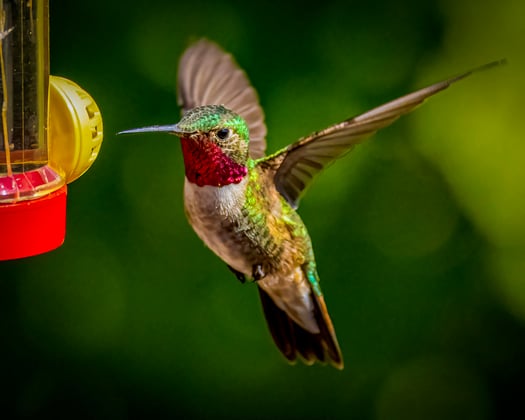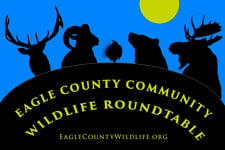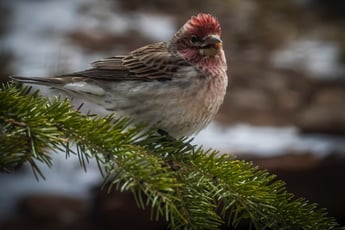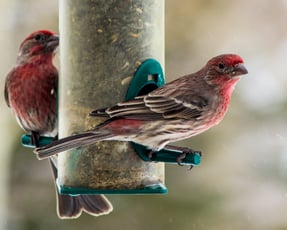Winter Bird Feeding
If you set out bird feeders, you are not alone. The US Fish and Wildlife Service estimates that...


Birds are a significant part of the wildlife in the ecosystems of Eagle County and around the world. eBird data shows that there have been 290 bird species recorded in Eagle County, Colorado.
There is an organization called the Cornell Lab of Ornithology. The lab's mission: “interpreting and conserving the Earth's biological diversity through research, education, and citizen science focused on birds.” 100,000 members, citizen scientists, and others support the lab.
Cornell lab has developed two smartphone apps, eBird and Merlin, that the public can use to help ID birds and keep records of those birds. The data on birds from the apps are then sent to Cornell to aid in their research. The apps will work with all smartphones. Cornell used data from these apps and other resources and came up with a startling finding!!!

Waterfowl hunters help ensure the sustainable management of waterfowl populations and the preservation of valuable wetlands for mallards and many other bird species. Steel shot is now used instead of the lead that poisoned many birds.
These losses are birds from every biome and ecosystem. A biome is a broad region, like a desert or rainforest.
An ecosystem is a more specific environment like a pond in a desert or a patch of forest in a rainforest. Forests have lost 1 billion birds. Grasslands have lost 720 million birds. The research has shown that common birds, the ones we see at our birdfeeders, have suffered the greatest losses. These numbers include sparrows, blackbirds, warblers, jays, and finches. Populations have declined as well as the number of species.
My observations fall in line with these reports. In the last few years something is different! I am seeing fewer birds and fewer species. Some of the ponds I would visit on a regular basis would have many birds and many species. I have been to these ponds lately and seen a couple of common birds, and there have been times when I saw nothing.
My bird feeders are no longer heavily used. Over more than 20 years I used to replace a quart size hummingbird feeder that had been emptied in 4-5 days. Last year and this year I have used a cup sized feeder and often empty an inch or two at the end of the week just because I felt it needed to be cleaned. The Western Hummingbird Partnership states that “Data on migratory hummingbirds has made it clear that some species are facing significant threats that have resulted in population declines of more than 60% since the 1970s.”
 |
 |
| The American goldfinch may be one of many colorful birds you may see at your feeders. The eBird and Merlin apps will help identify and keep track of birds seen. | Hummingbird feeders are a draw to 4 species of humming birds in the county, including the most common, the broad-tailed hummingbird. |
In 2014 I created a photo list of all the birds I saw at my feeders, I set up a camera with a remote shutter. When I saw something new at the feeders, I triggered the camera. There are 29 species in the list, all in one calendar year. I reviewed that list recently and in the last year I have only seen 11 of the species in that document.
I drive a lot of the county roads watching for wildlife and birds to photograph. On those trips I have seen only one rough-legged hawk in the past two years when in the past I would often see one or more on every trip I took. The same is true for northern harriers. These were not the same individual birds since I was at many locations.
For this article I talked with a lot of “birders” that I know, and they all agree that numbers are down and something really is different. A person suggested that global warming is pushing the birds north. If that were true, why are we not seeing species that are usually common south of us that moved here?
The eBird app is a tool for a citizen science project developed by the Cornell Lab of Ornithology that produces a global database that contributes to scientific research and conservation efforts related to bird observations. The eBird smartphone app allows birders to submit and share their bird observations, track their own sightings, and explore bird populations around the world. Birders can use the app to help them locate every species of bird recorded by birders worldwide. It also provides educational resources for learning about birds, where they are located, and tools to help with identification. The data from eBird goes to the Cornell Lab of Ornithology.
 Hairy woodpeckers and others eat insects and make holes in trees for nests. Those holes are used as nests by many other species.
Hairy woodpeckers and others eat insects and make holes in trees for nests. Those holes are used as nests by many other species.
Identifying birds is getting easier with the Merlin app. The app can also keep track of a user’s observations and life list. Merlin, also developed by the Cornell Lab of Ornithology, is powered by billions of bird observations submitted from Merlin to the eBird app. It is a tool to help identify birds that users have or are currently observing using three different options.
1. Users can answer simple questions in the Merlin app about a bird they are trying to identify, and Merlin will provide a list of possible matches including photos.
2. The Merlin app can listen to the birds sounds around the user by employing a smartphone and provide real-time suggestions along with a photo of the possible bird.
3. In addition, a user can take a photo of the bird directly, or off the back of a camera that uses long lenses and submit it to the app. Merlin will provide suggestions and photos of the bird a user is looking at.
The Merlin app can then send the data to the eBird app and that data goes to the Cornell Lab of Ornithology to be used in their research.
Birds in Colorado and across the nation are being impacted by habitat loss and degradation, pesticides, insecticides, climate change, and invasive species. In addition to those factors a new problem is beginning to surface. Federal programs are on the chopping block. The science that provides support to preserve and safeguard birds may be reduced or eliminated. We may lose the agencies and the research that is necessary to address the threats to bird survival.
Some of that research addresses birds directly and some research addresses the factors that impacts birds. As an example, the North American Breeding Bird Survey and the Bird Banding Lab is supported by the U.S. Geological Survey and monitors the status and trends of North American bird populations. Those long-standing programs have been targeted for closure.
 Birds, like this warbler, are killed by collisions with windows, habitat loss, pesticides, climate change, and invasive species.
Birds, like this warbler, are killed by collisions with windows, habitat loss, pesticides, climate change, and invasive species.
There are many on-line resources that provide information about birds. The new BirdCast Migration Dashboard, found online, provides data from radar-based measurements of nocturnal bird migration. The total number of birds migrating, their directions, speeds, and altitudes are recorded for many regions in the country.
Birding is a big deal in terms of its economic impact. Birding in the US and around the world contributes to tourism, retail sales, and conservation funding. A 2022 study found that people involved in birding in the US spent $107.6 billion on trips, bird seed, and equipment. In addition, there were 1.4 million jobs that generated $279 billion in total economic output. Engagement in backyard birding involved 91 million people.
• Get the eBird and Merlin apps for your smartphone and become a “birder.”
• Make windows safer, day and night to avoid collisions
• Keep cats indoors. Estimates are that they kill 1.4 billion birds or more in the U.S
• Reduce lawns by planting native species
• Avoid pesticides and insecticides that spill over to other species
• Put out bird feeders, be bear wise and bear aware, and maintain feeders to avoid disease
• Support legislation that protects the natural world around us
• Improve your knowledge about birds with internet searches and magazine articles
• Watch birds, become a “birder,” and share what you see
 |
 |
| Western tanagers are one of many brightly colored birds attracted to feeders for birders enjoyment. | Turkey vultures are part of the environmental cleanup crew that remove the carcass of many animals that die in the environment. |
Bird watchers are one of science’s most vital sources of data on how the ecological world is faring.
Birds are critical for healthy ecosystems. They are involved with pollinating flowers, controlling pests, dispersing seeds, and cleaning up carcasses that can spread disease. A decline in birds will have an impact on ecosystems around the world.
There are many personal benefits of birding that contribute to good health and happiness. Those benefits include mental and cognitive health, physical health, and stress reduction. Birding can provide social interactions and a connection with nature. Birding has a major economic impact around the world. All ages and abilities can participate in birding.
Are you a participant?
The Eagle County Community Wildlife Roundtable is a collaborative partnership with the White River National Forest, Colorado Parks and Wildlife, Bureau of Land Management, local government entities, community members, and citizen scientists. The purpose of the Eagle County Community Wildlife Roundtable is to gather a group of diverse stakeholders in the valley to understand and address issues facing wildlife populations. Together we will identify a shared vision and realistic actions that the community can rally around to support wildlife. We want to leverage diverse values, creativity, and resources to move toward positive action.

The Eagle County Community Wildlife Roundtable is a collaborative partnership with the White River National Forest, Colorado Parks and Wildlife, Bureau of Land Management, local government entities, community members, and citizen scientists. The purpose of the Eagle County Community Wildlife Roundtable is to gather a group of diverse stakeholders in the valley to understand and address issues facing wildlife populations. Together we will identify a shared vision and realistic actions that the community can rally around to support wildlife. We want to leverage diverse values, creativity, and resources to move toward positive action.


If you set out bird feeders, you are not alone. The US Fish and Wildlife Service estimates that...


Are you one of the 59 million people who feed birds? If yes, you are involved in the second most...